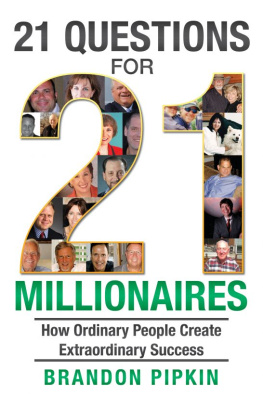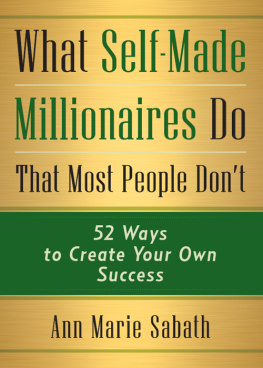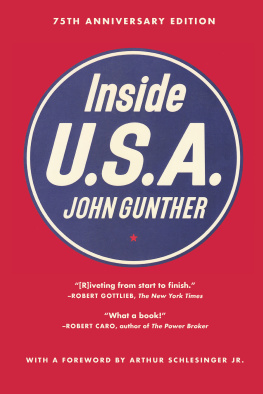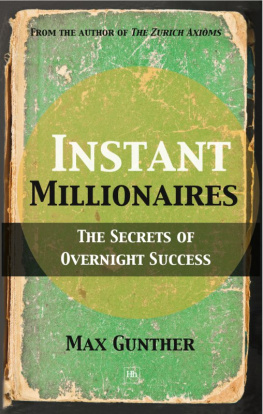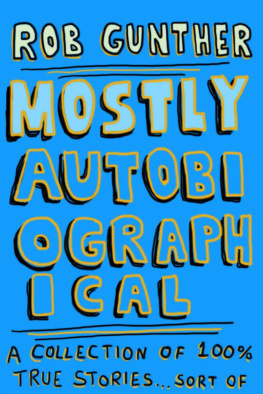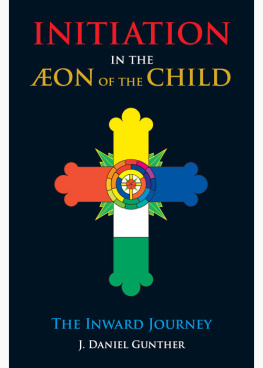Max Gunther (1926-1998), born in England, went to the United States when he was 11 years old, attended schools in New Jersey and received his BA from Princeton University in 1949. He served in the US Army in 1950 and 1951 and was a staff member of Business Week from 1951 to 1955. Mr Gunther then served as a contributing editor of Time for two years. From 1956 he published articles in several magazines, including Playboy. Among his other books are The Zurich Axioms, The Luck Factor, How to Get Lucky and Instant Millionaires.
Mr Gunther lived in Ridgefield, Connecticut, where his wife was a real-estate broker. They had three children. The author said that his diversions included surfing and skating, carving chess sets and playing chess, and painting.
Editors Note
In 1972 Max Gunther invited readers to take a journey with him through a gallery of Americas most prominent millionaires. It was a golden gallery indeed, since the inhabitants framed here are by no means merely ordinary millionaires. A minimum qualifying standard to be considered for inclusion in Gunthers list is ownership of assets valued at $100 million or more (the equivalent of $500 million today).
We are dealing, then, with the astonishingly affluent, the crme de la crme of the self-made rich.
As Gunther makes plain from the outset of this inquiry into fortune, the wealthy are not just ordinary people, and among the wealthy the very, very rich are an even more specialised breed. It takes an extremely particular type of mindset and approach to accumulate the wealth that the men profiled here did and it was the desire to discover this mindset and approach that spurred Gunthers quest.
The Very, Very Rich is a survey of the lives and character traits of Americas super rich and, most importantly, an analysis of the methods they employed to generate their huge swathes of capital.
To name but a few of the luminaries included: we meet a salesman in W. Clement Stone; massively successful jacks-of-all-trades in Howard Hughes and William Lear; a stock market speculator in Joseph Hirshhorn; and exponents of OPM (other peoples money) and OPW (other peoples work), in Daniel Ludwig, James Ling and Ray Kroc.
Though The Very, Very Rich may very well be read for simple entertainment, Gunther intended it to also have a practical application as a guide for those who themselves harbour dreams of ascending the ladder to supreme fortune.
This classic is now nearly 40 years old but its value endures since, as Gunther is keen to impress upon readers, the key steps on the route to wealth do not change with time. Those contained in this book can be learned from, adapted and applied by anyone today.
Harriman House
September 2010
The wealth of the very, very rich in todays terms
In 1972, when this book was first published, $1 had the same buying power as $5.22 in 2010. (According to calculations by the US Department of Labor, www.bls.gov/data.)
This table shows those featured in the book with their fortunes as they would now be in modern US dollar terms.
Self-made fortunes of the very, very rich (in 2010 terms adjusted for inflation)
| Gallery member | Wealth in 2010 |
| J. Paul Getty | $5.3 billion |
| Howard Hughes | $5.3 billion |
| Daniel Ludwig | $5.3 billion |
| Edwin Land | $2.6 billion |
| W. Clement Stone | $2.1 billion |
| William Lear | $1.1 billion |
| William Benton | $780 million |
| Bernard Cornfeld | $780 million |
| Conrad Hilton | $522 million |
| Joseph Hirshhorn | $522 million |
| Ray Kroc | $522 million |
| The Levitts | $522 million |
| James Ling | $522 million |
| Jeno Paulucci | $522 million |
| Glenn Turner | $522 million |
1. The Golden Gallery
COME WITH ME NOW, ye seekers, and stand before this great golden door. In a while we will turn the jeweled key and go in. Step softly. Speak in whispers. You in the back, there, get rid of that damned beer can. We are about to enter the presence of Wealth.
Did I pronounce it with an awestruck capital W? I intended to. This is not ordinary wealth we are about to study, not the mere upper crust, not even the tribe of mere millionaires. No, we are about to see Wealth in its most exaggerated some would say gorgeous, some would say disgusting manifestations. The very poorest individuals well meet will have net assets of $100 million or not far below, and some will have more than a billion.
What is the purpose of our visit to this golden gallery? Why, you ask, should we study these, the immoderately rich?
It is a sharp question, and we must acknowledge from the start that some will say there is no sensible answer. Our quest, we will be told, is foolish. A historical record stretching back some 2500 years reveals that wealth and seekers after wealth and seekers after the seekers (in which final category we now find ourselves) have all been steadfastly jeered at in every clime and culture. Wealth, the 2500-year-old platitude goes, is only an ephemeral thing and may not even be real at all. A man is better advised to spend his life in quest of something else: truth, perhaps, or beauty, but not money. Money isnt worth the seeking.
Nobody knows who first noted that you cant take it with you probably a Cro-Magnon man bellyaching about his neighbors flashy new leopard skin. The Greek philosopher Theognis was one of the first to put the sour old clich in writing. No one goes to heaven with all his immense wealth, Theognis grumped in the Fifth or Sixth Century B.C. Very probably not a single year has since gone by in which some man of intellectual stature has not reiterated the thought in hopes of cooling off whatever rat race was then afoot. Cicero said it in materialist Rome. Shakespeare said it to the earthy Elizabethans, while, across the English Channel, Rembrandt, himself a moderately rich man, was saying it to the boom-maddened Dutch. Shelley said it in reference to a departed king named Ozymandias. Thoreau said it at Walden. It would probably be a safe bet that at least 100,000 novels published in the 20th century have said it one way or another. The Bible says it not once but many times.



